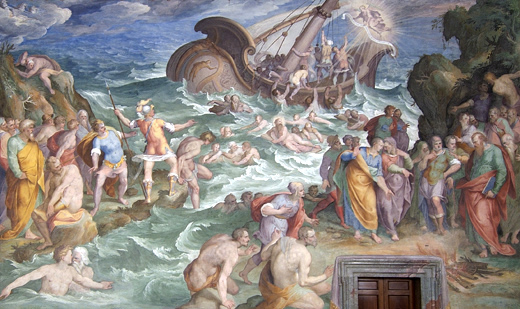Why do the nations conspire and the peoples plot in vain? The kings of the earth rise up and the rulers of the world take counsel together against the Lord and against his anointed, saying, “Let us break their chains and throw off their shackles.” — Psalm 2:1-2.
Psalm 2 seems written for our times. Since the beginning of Modernism, the world has been fiercely waging a war on both the natural and moral boundaries limiting the human condition. Absolute freedom is the ultimate aim of any form of Liberalism. The psalmist focuses on the vanity of that war by equating it to a war against God and his anointed. John 1:1-17 identifies that anointed as the Logos incarnated in Christ, the very light of existence, the unstoppable force that moves creation to its final destiny.
Revelation 1:8 shows Christ as the ultimate limit, the beginning and the end: “I am the Alpha and the Omega. . . .the One who is, and who was, and who is to come, the Almighty.” Thus those ideas of “liberation” are exposed as the ultimate folly: the imperfect unity of mankind – Babel’s flimsy mud bricks joined by bitumen – trying to overflow the bounds imposed on them by the perfect, indestructible unity of the Holy Trinity.
The rulers of the world plan to saw off the branch they’re sitting on. God finds their efforts laughable and decides to install a just king in their place, thus bringing an end to human pretention to self-rule.
The Psalm describes an impulse that has been part of the human condition since the fall of mankind. The desire to make the devil’s lie come true – “to be like God, knowing good and evil” – coincides with the foolish ambition of the kings of this world to acquire absolute freedom, anomía, a desire that is by definition impossible to fulfill.
St. John explains anomía (ἀνομία) as a characteristic of the Antichrist. From the Church’s beginnings, anomía was understood as the negation of the divine sonship of Christ and the paternity of God the Father. Jesus experienced that rejection, defining it as the non-acceptance of the love of the Father and the Son, a blasphemy against the Holy Spirit. (Mk. 3:28-29) All the apostolic communities experience that rejection, because it is present and operates within them. St. John and St. Paul prophesied the influence of that spirit would peak at the end of times.

The crisis currently affecting the Church is nothing more than another symptom, if not the final manifestation, of that evil spirit that wants to subordinate natural and moral limits to the will of man. Because the Church militant is made of human beings living in the world, contamination is always possible. Jesus warned his disciples about “the leaven of the Pharisees and Sadducees” who haughtily demanded a special sign from Jesus that would confirm him as the Messiah. In Matthew 16, that passage comes just before the establishment of the papacy.
Matthew 16:13-23 is a prophetic model of the history of the papacy. Jesus confirms that the Father has moved Peter to confess that the Messiah is the Son of God. In that moment, the Holy Trinity and Peter agree perfectly. The sign manifesting the unity of Heaven and Earth is the recognition of Jesus’ divine sonship. That is not the public sign that the enemies of Jesus were requesting but a secret sign reserved for the militant Church founded upon Peter, the Rock.
From that moment on, the mission of Simon Peter will be to “tie and untie” not the nets he was repairing that day when Jesus met him, but the divine net that will bring men into the Church for salvation. There is a hidden allegory here. Fishing nets are basically meant to limit the movement of fish. The new calling of Peter is similar to his old profession; his tying and untying will concern the living law of the Church until Christ returns in glory.
Up to that point, the parable develops quite predictably but that comes to an abrupt end when Jesus predicts his suffering and death. At that point, Peter rebukes the Lord. The fisherman can’t understand the Cross. He has allowed the leaven of human ideas to pollute his thoughts. He wants Jesus to be the Messiah that the Pharisees and Sadducees were expecting. He can’t see that way of understanding as opposed to the will of God.
This can be read as a compact prophecy encapsulating the history of the papacy. It begins with a perfect alignment with the will of God. But Peter’s destiny is to struggle with the spirit of anomía until Christ returns. Perhaps at a certain point, the “thoughts of men” will dominate the mind of a Pontiff and Peter’s barque will have to face a cosmic storm when the Church tries to align itself with the powers of the kings of this world.
St. John may help us understand why the agents of chaos have to be revealed in the Church: “They went out from us, but they did not really belong to us. For if they had belonged to us, they would have remained with us; but their going showed that none of them belonged to us.” (1 John 2:19)
This crisis is necessary for the purification of the Church. God is allowing that evil spirit to come to the surface. This is both the prelude of a storm that will bring the Church very close to the point of sinking, and also the sign that a great era of the Church will dawn after the storm has passed. Our orders are to stay on board and trust. Evil shall not prevail.
*Image: Shipwreck of St. Paul in Malta by Nicolò Circignani (known also as Pomarancio), c. 1580 [Meridian Hall, Archivum Secretum Vaticanum]















